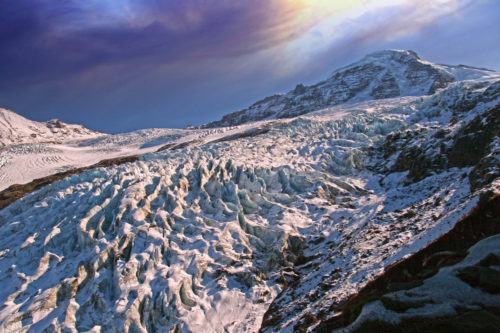Integral Ice : A Creative Residency reflection

By Manasseh Franklin
For much of the lower 48 states, it’s easy to consider glaciers as distant, sometimes extraordinarily so. A great deal of my research and writing focuses on closing this distance in order to give access to the beauty, vitality and total importance of ice on the decline throughout North America. To do this, I rely on intimate first hand experiences, scientific counsel and the compelling narrative of the landscapes themselves.
I came to the North Cascades Institute to write about ice. Fittingly, this region is home to the largest concentration of glaciers remaining in the lower 48. What I didn’t realize prior to arrival, however, is just how much that ice is integral to the livelihoods of people in this region, and how accessible that makes it on a day-to-day basis, both on the ice itself, but primarily off.
Being stationed at Diablo Lake provided the perfect starting point: glacial waters flowing through hydro-electric dams that power neighboring cities. Waters that, without glaciers, would not be able to provide the growing capacity of electricity needed in those places.
Through conversations at the North Cascades Environmental Learning Center, I was able to see the bigger picture not only of water and electricity but also glacial melt and how both its temperature and flow are integral to salmon runs. Glacial melt and its contribution to irrigation for orchards that supply fruit to the entire country. Glacial melt and the incredible milky emerald hue Lake Diablo took on during the final weeks of my stay in early June.
Not only did the landscape provide access to these integrated systems, but my encounters with the Environmental Learning Center did also, both for me and for the many groups of children and adults who were stationed there when I was. I found the mission of the center to resonate with my own mission in writing: using intimate and educated experiences in the outdoors to inspire conservation (and appreciation) of diminishing resources.
Of course, the landscape provided that connectivity as well. Evidence of ice resounds in the countless waterfalls, hanging valleys, and the glaciers themselves—roughly 300 in the park alone—perched in high valleys and cirques. They, like glaciers throughout the world, are diminishing, but still very physically present in the lush landscapes of the North Cascades.
I can’t express enough how much I appreciated my time at the Environmental Learning Center. Not only was I able to be physically proximate to actual ice, but I was also able to integrate in a community of people passionate about sharing the intricacies of this incredibly diverse and inspiring ecosystem with others.
* * * * *
Top photo of Mount Baker by Skagit photographer Andy Porter, available for purchase on his website at www.andyporterimages.com
Manasseh Franklin was a Creative Resident at the North Cascades Environmental Learning Center in the Spring of 2016. She is a writer, mountain guide, educator and adventurer who seeks big, hearty landscapes, and then writes about the experience of them. Franklin graduated from the University of Wyoming with an MFA in Creative Nonfiction Writing and Environment and Natural Resources and seeks to bridge the gap between science and experiential narrative. Her words have appeared in AFAR, Rock and Ice, Trail Runner, Western Confluence, Aspen Sojourner, Yoga International and Suburban Life River Towns magazines, in addition to several newspapers, blogs and websites. Learn more about her work at http://glaciersinmotion.wordpress.com and http://manassehfrass.wordpress.com.

